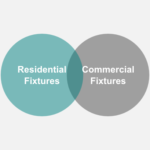
Commercial vs Residential Fixtures: What’s the difference?
It’s a definitional mess discerning the difference between “residential” and “commercial” lighting fixtures.
Everyone subjectively knows the difference between “residence” and “commerce”. But can one say that a product is one or the other? Is a sandwich “residential” or “commercial”?
So it is with trying to categorize light fixtures as either “residential” or “commercial.” For a certain fixture type, we can proclaim “never in my home” or “not at work”. But, we can also easily imagine exceptions.
In the lighting arena, two different definitions have come out of two different perspectives.
From a manufacturer’s point of view, there is a difference in “grade.” A “commercial-grade“ fixture is intended to last longer and withstand more use. It might have a tougher finish (paint) and a thicker body (lower gauge steel or aluminum). A “residential-grade” fixture might have a shorter warranty.
The manufacturer sends these different finished products into different “market channels.” Retail catalog operations, for instance, may only carry residential-grade. On the other hand, lighting designers and architects might only consider “spec-grade” or “architectural-grade.”
Even so, it’s entirely possible for a particular fixture style/type/look to be available in both residential-grade and commercial-grade versions.
Industry, then, provides market-based definitions, it’s what works for business.
A couple of decades ago, energy regulators wanted to insert efficiency metrics into the world of lighting products: Retail lighting was especially in need of a paradigm shift.
Regulators looked to find ways to define the universe of lighting fixtures that were “residential.” The thinking was that retail consumers must purchase certain types of product for their homes. Therefore, the presumption went, manufactures must intend such use for these types of products.
Today EnergyStar defines residential fixtures by way of intent: “A luminaire marketed and intended to be used in a residential environment notwithstanding use in commercial, business, and industrial environments.” “Intent” has always seemed a fuzzy way to define a product. Try asking a sandwich its intent!
Definitions get messier as EnergyStar goes on to declare “The EnergyStar label is primarily intended for products to be installed in residential applications, though some commercial-grade light fixtures are included in the program.” “Intent” and “grade” are here mixed. The commercial fixture types included in EnergyStar: accent lights (including line-voltage directional track lights), downlights (recessed, pendant, surface mount, and retrofits), under cabinet mounted, and portable desk lights.
So distinction does get muddy. We will use these names, commercial and residential, even when there is a confusing overlap. Of course, we should state here that any mild confusions are way more than offset by the massive gains that programs have achieved.
We covered the status of “commercial fixtures” in our previous post, at least those covered by DLC. Our next report will be on directional fixtures covered by EnergyStar, which include EnergyStar’s allowable commercial fixture types.

